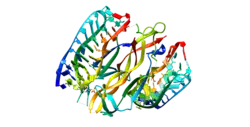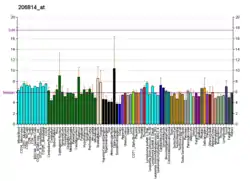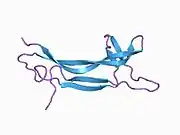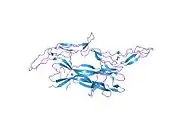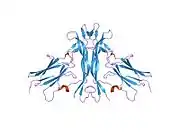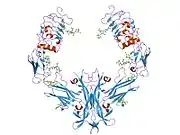Nerve growth factor
Nerve growth factor (NGF) is a neurotrophic factor and neuropeptide primarily involved in the regulation of growth, maintenance, proliferation, and survival of certain target neurons. It is perhaps the prototypical growth factor, in that it was one of the first to be described. Since it was first isolated by Nobel Laureates Rita Levi-Montalcini and Stanley Cohen in 1956, numerous biological processes involving NGF have been identified, two of them being the survival of pancreatic beta cells and the regulation of the immune system.
Structure
NGF is initially in a 7S, 130-kDa complex of 3 proteins – Alpha-NGF, Beta-NGF, and Gamma-NGF (2:1:2 ratio) when expressed. This form of NGF is also referred to as proNGF (NGF precursor). The gamma subunit of this complex acts as a serine protease, and cleaves the N-terminal of the beta subunit, thereby activating the protein into functional NGF.
The term nerve growth factor usually refers to the 2.5S, 26-kDa beta subunit of the protein, the only component of the 7S NGF complex that is biologically active (i.e. acting as a signaling molecule).
Function
As its name suggests, NGF is involved primarily in the growth, as well as the maintenance, proliferation, and survival of nerve cells (neurons). In fact, NGF is critical for the survival and maintenance of sympathetic and sensory neurons, as they undergo apoptosis in its absence.[5] However, several recent studies suggest that NGF is also involved in pathways besides those regulating the life cycle of neurons.
Neuronal proliferation
NGF can drive the expression of genes such as bcl-2 by binding to the Tropomyosin receptor kinase A, which stimulates the proliferation and survival of the target neuron.
High affinity binding between proNGF, sortilin, and p75NTR can result in either survival or programmed cell death. Study results indicate that superior cervical ganglia neurons that express both p75NTR and TrkA die when treated with proNGF,[6] while NGF treatment of these same neurons results in survival and axonal growth. Survival and PCD mechanisms are mediated through adaptor protein binding to the death domain of the p75NTR cytoplasmic tail. Survival occurs when recruited cytoplasmic adaptor proteins facilitate signal transduction through tumor necrosis factor receptor members such as TRAF6, which results in the release of nuclear factor κB (NF-κB) transcription activator.[7] NF-κB regulates nuclear gene transcription to promote cell survival. Alternatively, programmed cell death occurs when TRAF6 and neurotrophin receptor interacting factor (NRIF) are both recruited to activate c-Jun N-terminal kinase (JNK); which phosphorylates c-Jun. The activated transcription factor c-Jun regulates nuclear transcription via AP-1 to increase pro-apoptotic gene transcription.[7]
Proliferation of pancreatic beta cells
There is evidence that pancreatic beta cells express both the TrkA and p75NTR receptors of NGF. It has been shown that the withdrawal of NGF induces apoptosis in pancreatic beta cells, signifying that NGF may play a critical role in the maintenance and survival of pancreatic beta cells.[8]
Regulation of the immune system
NGF plays a critical role in the regulation of both innate and acquired immunity. In the process of inflammation, NGF is released in high concentrations by mast cells, and induces axonal outgrowth in nearby nociceptive neurons. This leads to increased pain perception in areas under inflammation. In acquired immunity, NGF is produced by the Thymus as well as CD4+ T cell clones, inducing a cascade of maturation of T cells under infection.[9]
Ovulation
NGF is abundant in seminal plasma. Recent studies have found that it induces ovulation in some mammals e.g. "induced" ovulators, such as llamas. Surprisingly, research showed that these induced animals will also ovulate when semen from on-schedule or "spontaneous" ovulators, such as cattle is used. Its significance in humans is unknown. It was previously dubbed ovulation-inducing factor (OIF) in semen before it was identified as beta-NGF in 2012.[10]
Mechanism of action
NGF binds with at least two classes of receptors: the tropomyosin receptor kinase A (TrkA) and low-affinity NGF receptor (LNGFR/p75NTR). Both are associated with neurodegenerative disorders.
When NGF binds to the TrkA receptor, it drives the homodimerization of the receptor, which in turn causes the autophosphorylation of the tyrosine kinase segment.[11] The tropomyosin receptor kinase A receptor has five extracellular domains, and the fifth domain is sufficient in binding NGF.[12] Once bound, the complex undergoes endocytosis and activates the NGF transcriptional program, following two major pathways, the Ras/MAPK pathway and the PI3K/Akt pathway.[11] The binding of NGF to TrkA also leads to the activation of PI 3-kinase, ras, and PLC signaling pathways.[13] Alternatively, the p75NTR receptor can form a heterodimer with TrkA, which has higher affinity and specificity for NGF.
Studies suggest that NGF circulates throughout the entire body via the blood plasma, and is important for the overall maintenance of homeostasis.[14]
Neuron survival
Binding interaction between NGF and the TrkA receptor facilitates receptor dimerization and tyrosine residue phosphorylation of the cytoplasmic tail by adjacent Trk receptors.[15] Trk receptor phosphorylation sites operate as Shc adaptor protein docking sites, which undergo phosphorylation by the TrkA receptor[7] Once the cytoplasmic adaptor protein (Shc) is phosphorylated by the receptor cytoplasmic tail, cell survival is initiated through several intracellular pathways.
One major pathway leads to the activation of the serine/threonine kinase, Akt. This pathway begins with the Trk receptor complex-recruitment of a second adaptor protein called growth factor-receptor bound protein-2 (Grb2) along with a docking protein called Grb2-associated Binder-1 (GAB1).[7] Subsequently, phosphatidylinositol-3 kinase (PI3K) is activated, resulting in Akt kinase activation.[7] Study results have shown that blocking PI3K or Akt activity results in death of sympathetic neurons in culture, regardless of NGF presence.[16] However, if either kinase is constitutively active, neurons survive even without NGF.[16]
A second pathway contributing to cell survival occurs through activation of the mitogen-activated protein kinase (MAPK) kinase. In this pathway, recruitment of a guanine nucleotide exchange factor by the adaptor and docking proteins leads to activation of a membrane-associated G-protein known as Ras.[7] The guanine nucleotide exchange factor mediates Ras activation through the GDP-GTP exchange process. The active Ras protein phosphorylates several proteins, along with the serine/threonine kinase, Raf.[7] Raf in turn activates the MAPK cascade to facilitate ribosomal s6 kinase (RSK) activation and transcriptional regulation.[7]
Both Akt and RSK, components of the PI3K-Akt and MAPK pathways respectively, act to phosphorylate the cyclic AMP response element binding protein (CREB) transcription factor.[7] Phosphorylated CREB translocates into the nucleus and mediates increased expression of anti-apoptotic proteins,[7] thus promoting NGF-mediated cell survival. However, in the absence of NGF, the expression of pro-apoptotic proteins is increased when the activation of cell death-promoting transcription factors such as c-Jun are not suppressed by the aforementioned NGF-mediated cell survival pathways.[7]
History
Rita Levi-Montalcini and Stanley Cohen discovered NGF in the 1950s while faculty members at Washington University in St Louis. However, its discovery, along with the discovery of other neurotrophins, was not widely recognized until 1986, when it won the Nobel Prize in Physiology or Medicine.[17][18][19]
Studies in 1971 determined the primary structure of NGF. This eventually led to the discovery of the NGF gene.
NGF is abundant in seminal plasma. Recent studies have found that it induces ovulation in some mammals.[20] Nerve Growth Factors (NGF) were initially discovered due to their actions during development, but NGF are now known to be involved in the function throughout the life of the animal.[21]
Interactions
Nerve growth factor has been shown to interact with Tropomyosin receptor kinase A.[22]
See also
- Protein targeting
- Nervous system
- VGF Nerve Growth Factor-inducible, a protein whose expression is induced by NGF
- Neurotrophin
- Nerve growth factor receptor
- Growth factor
- Brain-derived neurotrophic factor
References
- GRCh38: Ensembl release 89: ENSG00000134259 - Ensembl, May 2017
- GRCm38: Ensembl release 89: ENSMUSG00000027859 - Ensembl, May 2017
- "Human PubMed Reference:". National Center for Biotechnology Information, U.S. National Library of Medicine.
- "Mouse PubMed Reference:". National Center for Biotechnology Information, U.S. National Library of Medicine.
- Freeman RS, Burch RL, Crowder RJ, Lomb DJ, Schoell MC, Straub JA, Xie L (2004). "NGF deprivation-induced gene expression: after ten years, where do we stand?". NGF and Related Molecules in Health and Disease. Progress in Brain Research. Vol. 146. pp. 111–26. doi:10.1016/S0079-6123(03)46008-1. ISBN 978-0-444-51472-1. PMID 14699960.
- Lee R, Kermani P, Teng KK, Hempstead BL (Nov 2001). "Regulation of cell survival by secreted proneurotrophins". Science. 294 (5548): 1945–48. Bibcode:2001Sci...294.1945L. doi:10.1126/science.1065057. PMID 11729324. S2CID 872149.
- Sanes DH, Thomas AR, Harris WA (2011). "Naturally-occurring neuron death". Development of the Nervous System, Third Edition. Boston: Academic Press. pp. 171–208. ISBN 978-0-12-374539-2.
- Pierucci D, Cicconi S, Bonini P, Ferrelli F, Pastore D, Matteucci C, Marselli L, Marchetti P, Ris F, Halban P, Oberholzer J, Federici M, Cozzolino F, Lauro R, Borboni P, Marlier LN (Oct 2001). "NGF-withdrawal induces apoptosis in pancreatic beta cells in vitro". Diabetologia. 44 (10): 1281–95. doi:10.1007/s001250100650. PMID 11692177.
- Lambiase A, Bracci-Laudiero L, Bonini S, Bonini S, Starace G, D'Elios MM, De Carli M, Aloe L (Sep 1997). "Human CD4+ T cell clones produce and release nerve growth factor and express high-affinity nerve growth factor receptors". The Journal of Allergy and Clinical Immunology. 100 (3): 408–14. doi:10.1016/s0091-6749(97)70256-2. PMID 9314355.
- Ratto MH, Leduc YA, Valderrama XP, van Straaten KE, Delbaere LT, Pierson RA, Adams GP (Sep 2012). "The nerve of ovulation-inducing factor in semen". Proceedings of the National Academy of Sciences of the United States of America. 109 (37): 15042–47. Bibcode:2012PNAS..10915042R. doi:10.1073/pnas.1206273109. PMC 3443178. PMID 22908303.
- Meghan Rosen (August 20, 2012). "Ovulation spurred by newfound semen ingredient". Science News. Archived from the original on 2012-08-24.
- Stoleru B, Popescu A, Tache D, Neamtu O, Emami G, Tataranu L, Buteica A, Dricu A, Purcaru S (2013). "Tropomyosin-Receptor-Kinases Signaling in the Nervous System". Maedica. 8 (1): 43–48. PMC 3749761. PMID 24023598.
- Wiesmann C, Ultsch MH, Bass SH, de Vos AM (September 1999). "Crystal structure of nerve growth factor in complex with the ligand-binding domain of the TrkA receptor". Nature. 401 (6749): 184–88. Bibcode:1999Natur.401..184W. doi:10.1038/43705. PMID 10490030. S2CID 4337786.
- Marlin MC, Li G (2015). "Biogenesis and function of the NGF/TrkA signaling endosome". International Review of Cell and Molecular Biology. 314: 239–57. doi:10.1016/bs.ircmb.2014.10.002. ISBN 9780128022832. PMC 4307610. PMID 25619719.
- Levi-Montalcini R (2004). "The nerve growth factor and the neuroscience chess board". NGF and Related Molecules in Health and Disease. Progress in Brain Research. Vol. 146. pp. 525–27. doi:10.1016/s0079-6123(03)46033-0. ISBN 9780444514721. PMID 14699984.
- Kaplan DR, Martin-Zanca D, Parada LF (Mar 1991). "Tyrosine phosphorylation and tyrosine kinase activity of the trk proto-oncogene product induced by NGF". Nature. 350 (6314): 158–60. Bibcode:1991Natur.350..158K. doi:10.1038/350158a0. PMID 1706478. S2CID 4241996.
- Crowder RJ, Freeman RS (Apr 1998). "Phosphatidylinositol 3-kinase and Akt protein kinase are necessary and sufficient for the survival of nerve growth factor-dependent sympathetic neurons". The Journal of Neuroscience. 18 (8): 2933–43. doi:10.1523/JNEUROSCI.18-08-02933.1998. PMC 6792598. PMID 9526010.
- The 1986 Nobel Prize in Physiology or Medicine for discoveries of growth factors
- Presentation Speech by Professor Kerstin Hall The Nobel Prize in Physiology or Medicine 1986
- Rita Levi-Montalcini – Nobel Lecture
- Ovulation spurred by newfound semen ingredient
- Adelman, George. Encyclopedia of Neuroscience . Boston: Birkhhaeuser, 1987. Print.
- Nykjaer A, Lee R, Teng KK, Jansen P, Madsen P, Nielsen MS, Jacobsen C, Kliemannel M, Schwarz E, Willnow TE, Hempstead BL, Petersen CM (Feb 2004). "Sortilin is essential for proNGF-induced neuronal cell death". Nature. 427 (6977): 843–48. Bibcode:2004Natur.427..843N. doi:10.1038/nature02319. PMID 14985763. S2CID 4343450.
External links
- Nerve+Growth+Factor at the U.S. National Library of Medicine Medical Subject Headings (MeSH)
- Overview of all the structural information available in the PDB for UniProt: P01138 (Human Beta-nerve growth factor) at the PDBe-KB.
- Overview of all the structural information available in the PDB for UniProt: P01139 (Mouse Beta-nerve growth factor) at the PDBe-KB.
